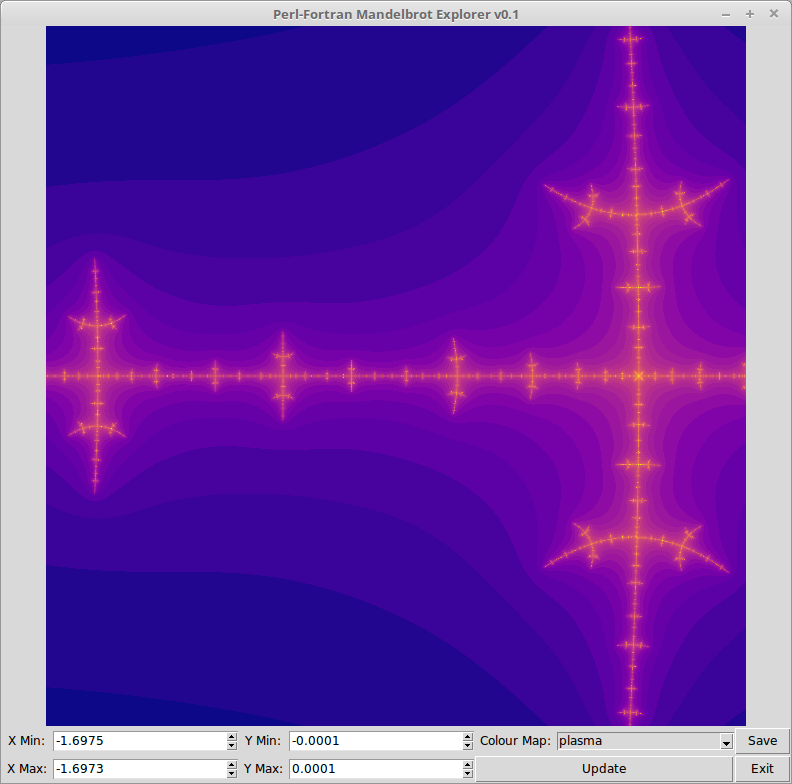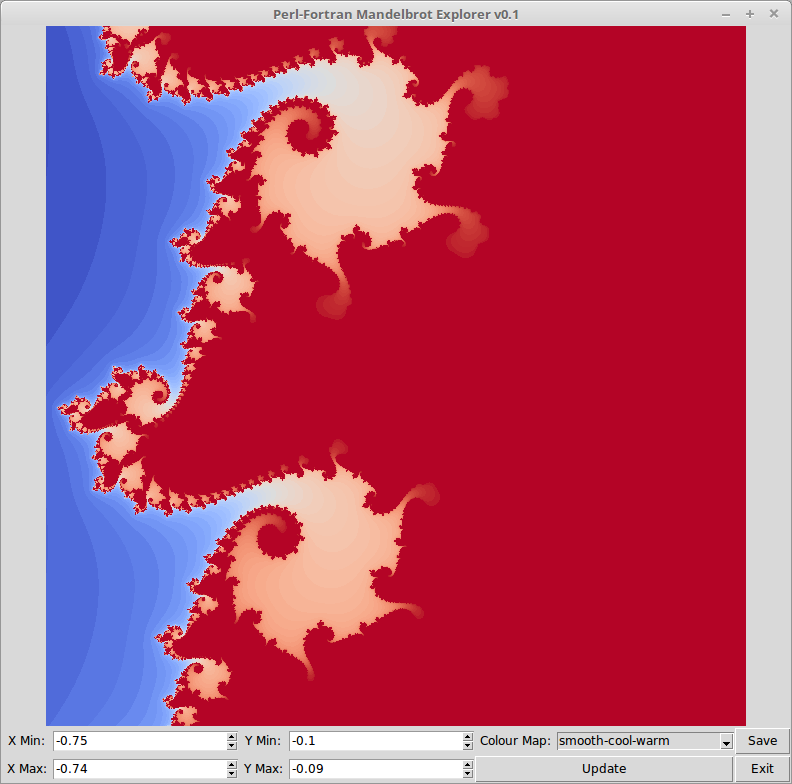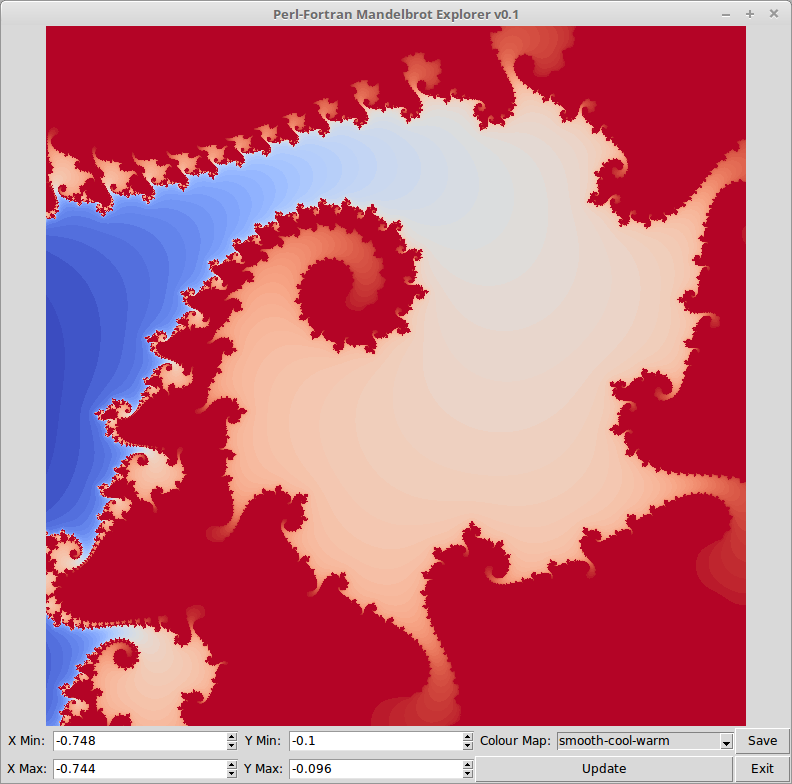Source Code - Fortran
! Have compiled with: gfortran -shared -fPIC -O3 -march=native -ffast-math -funroll-loops -o libmandelbrot.so types.f90 constants.f90 utils.f90 mesh.f90 do_mandelbrot.f90
! Adapted from the Fortran code at: https://www.fortran90.org/src/rosetta.html#mandelbrot-set
! Needs types.f90, constants.f90, utils.f90 and mesh.f90 from https://github.com/certik/fortran-utils
! Believe this is MIT licence
subroutine do_mandelbrot(x_min, x_max, y_min, y_max, density, fractal)
use types, only: dp
use constants, only: i_
use mesh, only: linspace, meshgrid
implicit none
real(dp), intent(in) :: x_min, x_max, y_min, y_max
integer, intent(in) :: density
integer, intent(out), dimension(density, density) :: fractal
real(dp), dimension(density, density) :: x, y, fractal_r
complex(dp), dimension(density, density) :: c, z
integer, parameter :: iter = 100
integer :: n
real(dp) :: maxv, minv
call meshgrid(linspace(x_min, x_max, density), linspace(y_min, y_max, density), x, y)
c = x + i_*y
z = c
fractal = 255
do n = 1, iter
where (abs(z) <= 10) z = z**2 + c
where (fractal == 255 .and. abs(z) > 10) fractal = 254 * (n-1) / iter
end do
fractal = transpose(fractal) ! adjust for different row/column order between Perl and Fortran
fractal_r = log(real(fractal, dp))
! rescale between 0 and 255 for colour map on the Perl end
minv = minval(fractal_r)
fractal_r = fractal_r - minv
maxv = maxval(fractal_r)
if ( maxv > 0 ) then
fractal = INT(255.0 * fractal_r / maxv)
else
fractal = 0
end if
end subroutine do_mandelbrot
Source Code - Perl
#!/usr/bin/perl
# Mandelbrot Set Explorer v0.1
use v5.16;
use Tkx;
use Imager;
use Text::CSV;
use MIME::Base64;
use FFI::Platypus 1.00;
# connect to Fortran function which generates Mandelbrot
# Fortran Mandelbrot code adapted from https://www.fortran90.org/src/rosetta.html#mandelbrot-set
my $ffi = FFI::Platypus->new( api => 1 );
$ffi->lang("Fortran");
$ffi->lib("./libmandelbrot.so");
$ffi->attach( do_mandelbrot => ['real_8*', 'real_8*', 'real_8*', 'real_8*', 'integer*', 'integer[]'] => 'void' );
# read in various colour maps from CSV files
my $colour_tables = read_colour_tables();
# initialise values
my $c_map = "plasma";
my $density = 700;
my ($x_min, $x_max, $y_min, $y_max) = (-2.68, 1.32, -1.5, 1.5);
my $size = $density * $density;
my @fractal = (0) x $size; # allocate memory for the fractal, Fortran will fill it in
my $img = Imager->new(xsize => $density, ysize => $density, channels => 3);
my $imgcount = 1; # for now give each saved png a number, see "save" button below
# initialise Mandelbrot and images
do_mandelbrot(\$x_min, \$x_max, \$y_min, \$y_max, \$density, \@fractal); # Fortran subroutine uses pass-by-reference
mandelbrot_to_imager();
# create Tk interface with Tkx (https://tkdocs.com)
my $mw = Tkx::widget->new(".");
$mw->g_wm_title("Perl-Fortran Mandelbrot Explorer v0.1");
$mw->g_wm_minsize(700, 700);
my $content = $mw->new_ttk__frame;
# Tkphoto to display the fractal
my $photo_label = $content->new_ttk__label(-image => imager_to_Tkphoto());
# button to update the fractal by calling Fortran and updating the Tkphoto (via Imager)
my $update_button = $content->new_button(
-text => "Update",
-command => sub {
do_mandelbrot(\$x_min, \$x_max, \$y_min, \$y_max, \$density, \@fractal);
mandelbrot_to_imager();
$photo_label->configure(-image => imager_to_Tkphoto());
},
);
# button to save current fractal to a png file using Imager
my $save_button = $content->new_button(
-text => "Save",
-command => sub {
$img->write(file => "mandelbrot_$imgcount.png");
$imgcount++;
},
);
# button to exit
my $exit_button = $content->new_button(
-text => "Exit",
-command => sub { $mw->g_destroy; },
);
# entries for x/y min/max
my $x_min_label = $content->new_ttk__label(-text => "X Min:", -padding => "5");
my $x_min_spin = $content->new_ttk__spinbox(-from => -3.0, -to => 3.0, -increment => 0.001, -textvariable => \$x_min, -format => '%.4f');
my $x_max_label = $content->new_ttk__label(-text => "X Max:", -padding => "5");
my $x_max_spin = $content->new_ttk__spinbox(-from => -3.0, -to => 3.0, -increment => 0.001, -textvariable => \$x_max, -format => '%.4f');
my $y_min_label = $content->new_ttk__label(-text => "Y Min:", -padding => "5");
my $y_min_spin = $content->new_ttk__spinbox(-from => -3.0, -to => 3.0, -increment => 0.001, -textvariable => \$y_min, -format => '%.4f');
my $y_max_label = $content->new_ttk__label(-text => "Y Max:", -padding => "5");
my $y_max_spin = $content->new_ttk__spinbox(-from => -3.0, -to => 3.0, -increment => 0.001, -textvariable => \$y_max, -format => '%.4f');
# colour map selection
my $c_map_label = $content->new_ttk__label(-text => "Colour Map:", -padding => "5");
my $c_map_combo = $content->new_ttk__combobox(-values => join(" ", keys %{$colour_tables}), -textvariable => \$c_map);
$c_map_combo->state("readonly");
$c_map_combo->g_bind( "<<ComboboxSelected>>", # a new colour map selected
sub {
$c_map_combo->selection_clear(); # for aesthetics, as suggested at https://tkdocs.com/tutorial/widgets.html#combobox
mandelbrot_to_imager(); # can update colour map without going back to Fortran to recalc the fractal
$photo_label->configure(-image => imager_to_Tkphoto());
});
# create a grid to arrange all the widgets
$content->g_grid(-column => 0, -row => 0);
$photo_label->g_grid(-column => 0, -row => 0, -columnspan => 7 );
$update_button->g_grid(-column => 4, -row => 2, -columnspan => 2, -sticky => "nsew");
$save_button->g_grid(-column => 6, -row => 1, -sticky => "nsew");
$exit_button->g_grid(-column => 6, -row => 2, -sticky => "nsew");
$x_min_label->g_grid(-column => 0, -row => 1);
$x_min_spin->g_grid(-column => 1, -row => 1);
$x_max_label->g_grid(-column => 0, -row => 2);
$x_max_spin->g_grid(-column => 1, -row => 2);
$y_min_label->g_grid(-column => 2, -row => 1);
$y_min_spin->g_grid(-column => 3, -row => 1);
$y_max_label->g_grid(-column => 2, -row => 2);
$y_max_spin->g_grid(-column => 3, -row => 2);
$c_map_label->g_grid(-column => 4, -row => 1);
$c_map_combo->g_grid(-column => 5, -row => 1);
Tkx::MainLoop;
exit;
# read the colour tables from CSV files
# The colour map CSVs were found at: https://www.kennethmoreland.com/color-advice/
sub read_colour_tables {
my $csv = Text::CSV->new ( { binary => 1 } );
my %ct;
my @tables = qw(
bent-cool-warm-table-byte-0256.csv
black-body-table-byte-0256.csv
extended-kindlmann-table-byte-0256.csv
inferno-table-byte-0256.csv
kindlmann-table-byte-0256.csv
plasma-table-byte-0256.csv
smooth-cool-warm-table-byte-0256.csv
viridis-table-byte-0256.csv
);
foreach my $table (@tables) {
next unless -e $table;
open(my $fh, "<:encoding(utf8)", $table) or warn "Cannot open $table: $!";
next unless defined $fh;
my $table_name = substr( $table, 0, -1 * length("-table-byte-0256.csv") );
READ_CSV: while ( my $r = $csv->getline( $fh ) ) {
next READ_CSV unless $r->[1] =~ /\A \d+ \z/ismx;
push @{ $ct{$table_name} }, [ $r->[1], $r->[2], $r->[3] ];
}
close($fh);
}
return \%ct;
}
# read the fractal data into Imager image via a colourmap
sub mandelbrot_to_imager {
my @ct_to_use = @{ $colour_tables->{$c_map} };
$img->read( type => 'raw',
data => pack("C*", map { @{$ct_to_use[$_]} } @fractal ),
xsize => $density,
ysize => $density,
raw_datachannels => 3,
raw_storechannels => 3,
raw_interleave => 0
) or die "Cannot read fractal: ", $img->errstr;
}
# push the Imager image into the Tkphoto
# method a bit involved, done as per recipe in https://metacpan.org/dist/Imager/source/samples/tk-photo.pl
sub imager_to_Tkphoto {
my $image_data;
$img->write( data => \$image_data, type => 'png' );
$image_data = encode_base64($image_data);
my $im = Tkx::image_create_photo( "Mandelbrot", -data => $image_data);
return $im;
}




